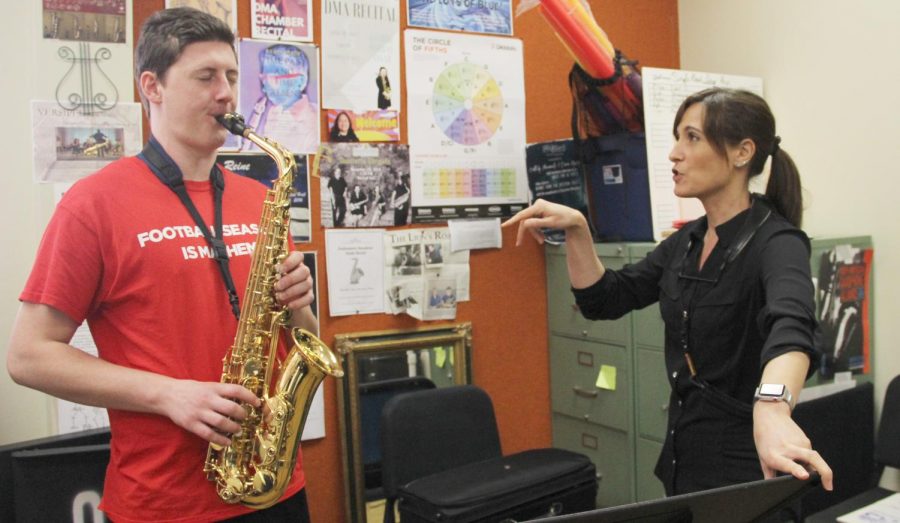Sax, song and photography piece the world of art together
Erica Welter/The Lion’s Roar
Brina Faciane, instructor of saxophone, teaches Austin Hynes, a junior music major, on the instrument.
In the vast and varied world of artistic pursuits, each craftsperson advocates for their discipline.
Brina Faciane, an instructor of saxophone, was drawn to music as a child.
“At some point, I realized I had some talent, and I just needed to work a little bit harder, and I could go to the next level,” said Faciane.
According to the article “The First Saxophone Was Made of Wood” published in the Smithsonian Magazine, the jazz icon was invented by a Belgian-born inventor named Adolphe Sax. It is one of the newer instruments in the musical landscape.
“The saxophone is just a really cool instrument,” stated Faciane. “It’s the baby in this building, if I can say that. If you think about flute, the flute’s been around forever. Clarinet’s been around a long time. Violins have been around forever. Piano’s been around forever. Saxophone was patented in 1846. So, it’s a baby if you think about it historically.”
While other art forms may require vision to appreciate, Faciane believes the best way to enjoy an orchestra is perhaps with one’s eyes closed.
“Our art form is completely aural,” explained Faciane. “You can attend a recital or a symphony and sit in the audience with your eyes closed the whole time and maybe have an even deeper experience than you would if you had your eyes open and watched the conductor and saw the musicians move.”
The Harry Ransom Center at the University of Texas at Austin dated the earliest known surviving photograph as being taken in 1826 or 1827. Photography has come a long way since then.
Lily Brooks, an instructor of photography, feels the craft has opened doors she may not have found otherwise.
“Photography interested me because I thought it would be a vehicle for me to interact with the world, perhaps travel beyond the familiar, or interact with strangers whose experiences were different than mine,” explained Brooks.
Brooks believes her work lends itself to interdisciplinary intellectual engagement.
“I work in a research based practice, so I am often investigating topics that interest me, which have nothing to do with art or photography,” said Brooks. “For instance, right now I am working on a project about the Bonnet Carre Spillway. I’m thinking about how this specific landscape holds evidence of the ways we try to control the natural world, our history of land use there and the way that economics, politics and culture can shape a place.”
One of Brooks’ favorite aspects of her craft is using her photography to create a connection with people.
“I love that most people have a relationship to pictures,” said Brooks. “They are, after all, how we often validate our experiences, hold on to them and also how we get much of our information.”
Alissa Rowe, director of choral activities and associate professor of voice, enjoys multiple facets of her craft. As a music teacher, conductor and singer, she landed her first stage role in the third grade.
Rowe finds that the differences between artistic pursuits largely depends on the medium used.
“I think if you’re a sculptor, you have to make the clay, or whatever you’re doing, come to life or mean something, and it’s whatever we’re using that makes our crafts a little bit different,” shared Rowe. “If you’re on stage, you’re taking the script, and you’re making it come alive. Each of us has our own tool with which we use to make that happen.”
Whether it is from the perspective of a singer or a conductor, Rowe enjoys sharing her craft with her students.
“I love interpreting the music,” said Rowe. “Bringing them my ideas and showing them what I love, that’s just the best just doing it and really feeling like I did that all on my own. I took that music, and I made it come alive off the page. It’s such an amazing feeling.”
Your donation will support The Lion's Roar student journalists at Southeastern Louisiana University.
In addition, your contribution will allow us to cover our annual website hosting costs.
No gift is too small.





